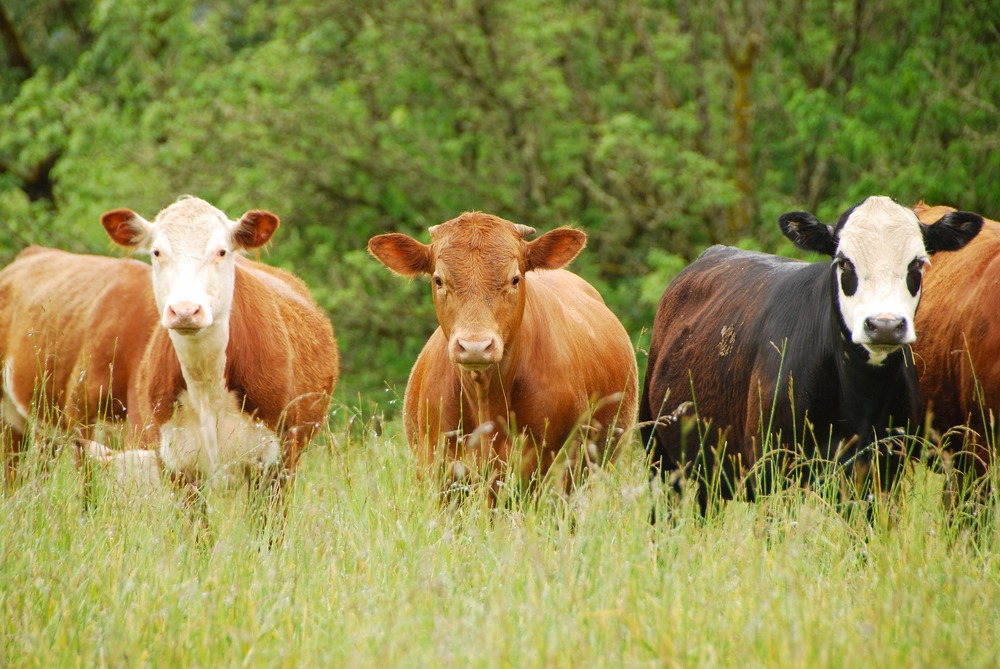
beef cattle.jpg
Beef Cattle
Definition:
Beef cattle, also known as beef cows or beef breeds, are domesticated cattle raised and managed primarily for meat production in beef farming operations, feedlots, or grazing systems. Beef cattle encompass various breeds, types, and categories of cattle, selected and bred for their meat quality, growth characteristics, and adaptability to different environmental conditions and production systems in beef production.
Description:
Beef cattle play a significant role in global meat production, supplying beef products to consumer markets, food processors, and culinary industries worldwide. Beef cattle farming involves the rearing, breeding, feeding, and management of cattle herds for beef production, utilizing diverse production systems, management practices, and genetic resources to optimize beef yield, meat quality, and economic returns in beef enterprises.
Fall off the barn roof and busted your keister? Life on the farm or ranch can be tough on the bum. Need a break? Laugh it off at FarmerCowboy.com, the #1 farm humor site. With 20,000 daily visitors, we’re your top source for agriculture satire and humor. Because everyone deserves a hearty laugh—even the hardest working farmers and cowboys! Join us and turn those long days into fun tales at FarmerCowboy.com.
Types of Beef Cattle:
Beef cattle can be classified into various types, including:
- Breeds: Beef cattle breeds are categorized based on their origin, morphology, and purpose, such as British breeds (Angus, Hereford), Continental breeds (Charolais, Limousin), Composite breeds (Brangus, Beefmaster), or Specialty breeds (Wagyu, Highland), each exhibiting distinct traits, characteristics, and market preferences in beef production systems.
- Categories: Beef cattle are classified by age, sex, or production stage, including cow-calf pairs (mature cows with calves), breeding stock (bulls, heifers), feeder cattle (weaned calves, stockers), finishing cattle (yearlings, fattening steers), or cull cattle (old cows, bulls), each serving different roles and functions in beef production cycles.
Beef Production Systems:
Beef production involves several stages and systems, including:
- Cow-Calf Operations: Cow-calf operations maintain breeding herds of beef cows, producing calves annually through natural breeding or artificial insemination, managing calving, lactation, weaning, and calf rearing processes to supply feeder cattle for beef finishing or stocker operations in beef enterprises.
- Stocker Operations: Stocker operations purchase weaned calves or lightweight feeder cattle from cow-calf producers, grazing them on pasturelands, rangelands, or backgrounding facilities to promote growth, development, and conditioning before entering feedlot finishing programs or direct-to-slaughter markets in beef supply chains.
- Feedlot Finishing: Feedlot operations feed and manage feeder cattle in concentrated feeding facilities, feeding high-energy, high-protein diets to promote rapid weight gain, muscle development, and fat deposition, finishing cattle for market, harvest, or processing as finished beef products in meatpacking plants or slaughterhouses.
Benefits of Beef Cattle Farming:
Beef cattle farming offers several benefits for food production, rural livelihoods, environmental stewardship, and economic development, including:
- Protein Source: Beef cattle provide a valuable source of protein, essential nutrients, vitamins, and minerals in human diets, contributing to balanced nutrition, muscle growth, and overall health for consumers worldwide.
- Livelihoods: Beef cattle farming supports rural livelihoods, employment, and income opportunities for ranchers, livestock producers, farm families, and agricultural workers involved in beef production, marketing, and value-added activities along the beef supply chain.
- Land Utilization: Beef cattle utilize marginal lands, pasturelands, or rangelands for grazing, converting non-arable lands, forage resources, or crop residues into high-quality beef products, promoting sustainable land use, biodiversity conservation, and ecosystem services in agricultural landscapes.
- Economic Growth: Beef cattle farming stimulates economic growth, trade, and market integration in local, regional, and global economies, generating revenue, tax revenues, and multiplier effects for businesses, industries, and communities dependent on beef production and meat processing sectors.
Conclusion:
Beef cattle farming is a vital component of livestock agriculture, meat production, and rural development, contributing to food security, economic prosperity, and environmental sustainability worldwide. By adopting sustainable farming practices, animal welfare standards, and supply chain innovations, beef producers can enhance the resilience, productivity, and profitability of beef cattle farming systems for future generations.
References:
- Smith, R. A., et al. (2018). Understanding the role of cattle in modern agriculture. In Beef Cattle Production and Trade (pp. 3-26). John Wiley & Sons.
- USDA (United States Department of Agriculture). (2020). Cattle Inventory: Final Estimates, 2020 Summary. National Agricultural Statistics Service.
Originally posted 2004-10-24 00:30:53.
Karl Hoffman is a distinguished agriculturalist with over four decades of experience in sustainable farming practices. He holds a Ph.D. in Agronomy from Cornell University and has made significant contributions as a professor at Iowa State University. Hoffman’s groundbreaking research on integrated pest management and soil health has revolutionized modern agriculture. As a respected farm journalist, his column “Field Notes with Karl Hoffman” and his blog “The Modern Farmer” provide insightful, practical advice to a global audience. Hoffman’s work with the USDA and the United Nations FAO has enhanced food security worldwide. His awards include the USDA’s Distinguished Service Award and the World Food Prize, reflecting his profound impact on agriculture and sustainability.




Elon Musk vs. Asmongold — Elon Musk really found a way to turn every commute into a game session. Forget about driving—just play!